Processors for space-scale tasks
I haven’t seen a task manager of a 4-socket system running on a 10-core processor for a long time ... Today, under the cut - a few words about the new Intel Xeon processors.

The beginning of the year was fruitful on new products - quite recently the corporation announced a whole assortment of desktop processors, and after them, just a few days ago, server solutions were updated.
')
 Two processor families were introduced at once - Intel Xeon E7 (codenamed Westmere-EX - they update the platform with Nehalem processors) and Intel Xeon E3 (based on the new Sandy Bridge architecture). Thus, the new processors can be divided into two groups: E3 for entry-level servers that are useful for small businesses; and E7 - the best features in its class, for high-performance computing (for example, in data centers). I recall involuntarily desktop processors (i3, i5 and i7) - whether Intel Xeon E5 processors will appear is still unclear.
Two processor families were introduced at once - Intel Xeon E7 (codenamed Westmere-EX - they update the platform with Nehalem processors) and Intel Xeon E3 (based on the new Sandy Bridge architecture). Thus, the new processors can be divided into two groups: E3 for entry-level servers that are useful for small businesses; and E7 - the best features in its class, for high-performance computing (for example, in data centers). I recall involuntarily desktop processors (i3, i5 and i7) - whether Intel Xeon E5 processors will appear is still unclear.
New items are represented by 29 models for 2-, 4- and 8-socket platforms and can be used for systems with 256-processor slots. All processors are manufactured using the new 32 nm technology.
 Comparative table of Intel Xeon E3 processors
Comparative table of Intel Xeon E3 processors
The processors are designed for the LGA1155 socket, and their TDP ranges from 20 (!) To 95 VTT. There is support for Intel Turbo Boost 2.0 technology, memory error correction (ECC), data encryption with Intel AES-NI.
The most interesting processor family is the Intel Xeon E7:
 Intel Xeon E7 Processor Comparison Chart
Intel Xeon E7 Processor Comparison Chart
Well, or a visual comparison of the characteristics separately for each series: 2800 4800 8800
As you can see, the changes have touched literally everything: the technical process has changed, the number of cores has increased (up to 10), the L3 cache size (now it is from 24 to 30 MB), the heat release has decreased (TDP for top models does not exceed 130 W). Low-voltage DIMMs are supported - if consumption drops by at least 1W from each “bar”, then in aggregate (in terms of a year), the savings will be quite substantial.
There are more than 20 features for fault tolerance, and a number of other hardware and software solutions, such as, for example, Intel TXT (Trusted eXecution Technology). By the end of the year, an entire ecosystem of software products (of the order of a hundred) is expected to appear, supporting E7 technologies. For example, processors of the new series are endowed with support for AES-NI encryption instructions - if previously software encryption of a truly large database was not the best idea, now (for example, in Oracle Database 11g Release 2) data encryption shows an increase of 10 times and can happen literally in real time.
Processors of the E7 series are made in the FC-LGA8 package and are aimed at interacting with the LGA 771 socket - an example of performance was shown to us on the same server that was used for this purpose exactly a year ago. All it took to upgrade was to update the BIOS and install new processors.
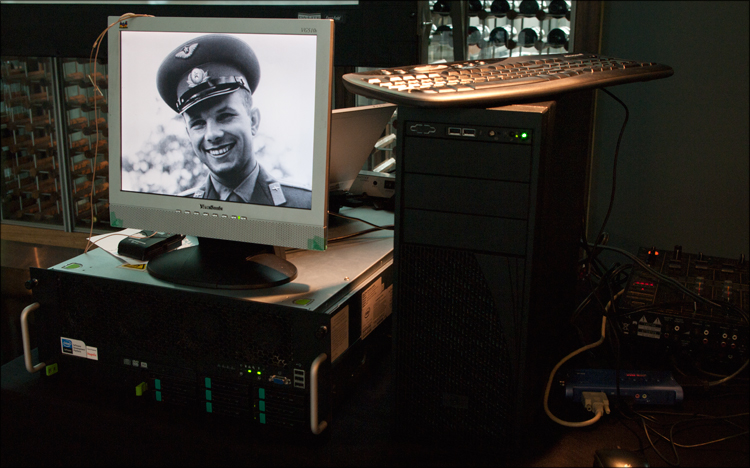
It is clear that simply taking and seriously burdening such a system is quite difficult - the correct use of such systems is like a whole science ... nevertheless, we were vividly shown an example of the difference in performance when using different optimization tools. Thus, the use of OpenMP has coped with the computational task 70 (!) Times faster than using a regular Intel Compiler. At the moment, the processors of this series managed to set 15 world records for x86-systems (with the number of sockets from 1 to 8).
 Video from the presentation
Video from the presentation
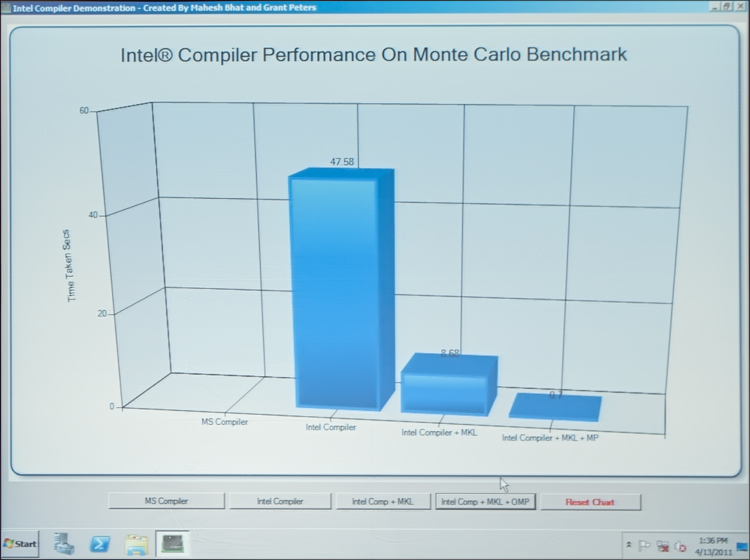
The keynote address was delivered by Andrei Semin, Director of Development for High Performance Computing in Europe, the Middle East and Africa. According to him, the age of configurations in many scalable systems exceeds 5 years, that is, they were purchased in 2006, in the era of dual-core processors. Since then, literally everything has been improved - virtualization, security, power management and server reliability ... well, what could be there, even if so much has changed in relation to the previous generation of processors. However, if we take into account those processors that were relevant in 2006, the server rack with the new Intel Xeon E7-4800 is 18 (!) Racks with Intel Xeon Dual Core. In this case, the gain in energy efficiency for the year will be 93%. In comparison with the processors of the previous generation (which I mentioned a year ago ), the performance gain will be at least 30%.

In his report, Andrei Semin stressed that the consistent work of Intel to improve the Intel Xeon line leads to the fact that for tasks of critical importance, customers choose x86-based systems, rather than other previously widely used architectures. That, in turn, stimulates the development of an ecosystem of solutions for large enterprises, in particular, * NIX-compatible operating systems, virtualization tools and database management, etc.
And according to some analysts, the next decade the server market will be consolidated on the basis of one technology - the x86 architecture.
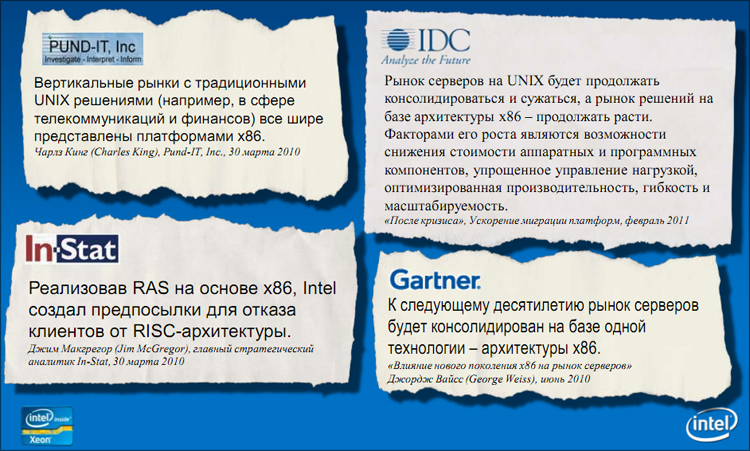
During the event, server solutions were presented (of course, already on the basis of new processors) from partner companies such as Aquarius, DEPO, ETergo, Kraftway and HP - for details, see the photos:

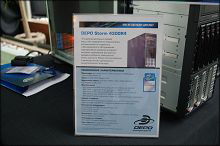
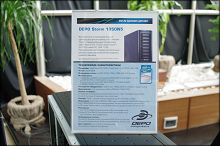
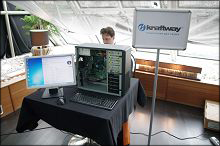


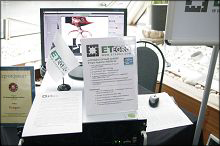



The announcement of the processors on this day took place for a reason - an event held on Cosmonautics Day was dedicated to the 50th anniversary of the first manned flight into space, which was carried out in 1961 by Russian Yuri Gagarin. Therefore, as a bonus, Vyacheslav Vetelev (from Kraftway) told us (and showed in the photos) about the anniversary launch of the rocket in the Baikonur cosmodrome. Unfortunately, I cannot retell everything (at least I did not remember it), but I will say this - the eyewitness story is much more interesting than everything that is shown on TV. Well, the very theme of space ... yes, now I understand why so many children dream of becoming astronauts!
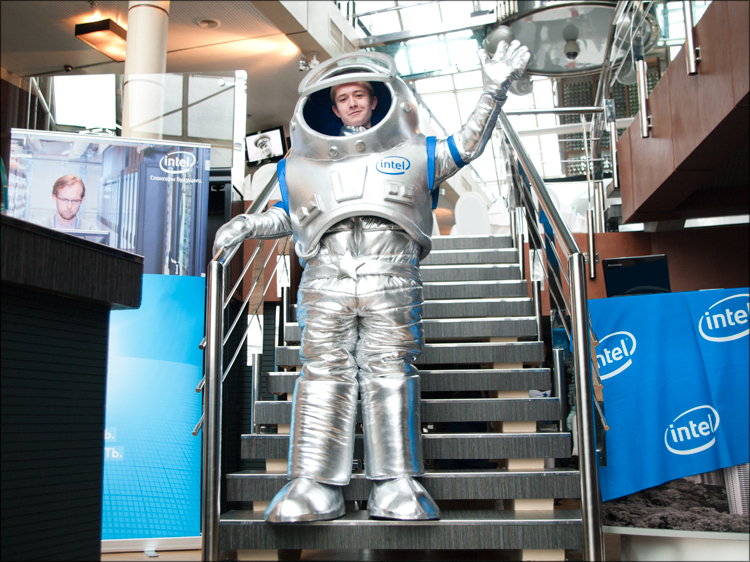
By the way, the new Intel Xeon E7 is quite suitable for solving problems including a space scale;)

The beginning of the year was fruitful on new products - quite recently the corporation announced a whole assortment of desktop processors, and after them, just a few days ago, server solutions were updated.
')
 Two processor families were introduced at once - Intel Xeon E7 (codenamed Westmere-EX - they update the platform with Nehalem processors) and Intel Xeon E3 (based on the new Sandy Bridge architecture). Thus, the new processors can be divided into two groups: E3 for entry-level servers that are useful for small businesses; and E7 - the best features in its class, for high-performance computing (for example, in data centers). I recall involuntarily desktop processors (i3, i5 and i7) - whether Intel Xeon E5 processors will appear is still unclear.
Two processor families were introduced at once - Intel Xeon E7 (codenamed Westmere-EX - they update the platform with Nehalem processors) and Intel Xeon E3 (based on the new Sandy Bridge architecture). Thus, the new processors can be divided into two groups: E3 for entry-level servers that are useful for small businesses; and E7 - the best features in its class, for high-performance computing (for example, in data centers). I recall involuntarily desktop processors (i3, i5 and i7) - whether Intel Xeon E5 processors will appear is still unclear.New items are represented by 29 models for 2-, 4- and 8-socket platforms and can be used for systems with 256-processor slots. All processors are manufactured using the new 32 nm technology.
 Comparative table of Intel Xeon E3 processors
Comparative table of Intel Xeon E3 processorsThe processors are designed for the LGA1155 socket, and their TDP ranges from 20 (!) To 95 VTT. There is support for Intel Turbo Boost 2.0 technology, memory error correction (ECC), data encryption with Intel AES-NI.
The most interesting processor family is the Intel Xeon E7:
 Intel Xeon E7 Processor Comparison Chart
Intel Xeon E7 Processor Comparison ChartWell, or a visual comparison of the characteristics separately for each series: 2800 4800 8800
As you can see, the changes have touched literally everything: the technical process has changed, the number of cores has increased (up to 10), the L3 cache size (now it is from 24 to 30 MB), the heat release has decreased (TDP for top models does not exceed 130 W). Low-voltage DIMMs are supported - if consumption drops by at least 1W from each “bar”, then in aggregate (in terms of a year), the savings will be quite substantial.
There are more than 20 features for fault tolerance, and a number of other hardware and software solutions, such as, for example, Intel TXT (Trusted eXecution Technology). By the end of the year, an entire ecosystem of software products (of the order of a hundred) is expected to appear, supporting E7 technologies. For example, processors of the new series are endowed with support for AES-NI encryption instructions - if previously software encryption of a truly large database was not the best idea, now (for example, in Oracle Database 11g Release 2) data encryption shows an increase of 10 times and can happen literally in real time.
Processors of the E7 series are made in the FC-LGA8 package and are aimed at interacting with the LGA 771 socket - an example of performance was shown to us on the same server that was used for this purpose exactly a year ago. All it took to upgrade was to update the BIOS and install new processors.

It is clear that simply taking and seriously burdening such a system is quite difficult - the correct use of such systems is like a whole science ... nevertheless, we were vividly shown an example of the difference in performance when using different optimization tools. Thus, the use of OpenMP has coped with the computational task 70 (!) Times faster than using a regular Intel Compiler. At the moment, the processors of this series managed to set 15 world records for x86-systems (with the number of sockets from 1 to 8).
 Video from the presentation
Video from the presentation
The keynote address was delivered by Andrei Semin, Director of Development for High Performance Computing in Europe, the Middle East and Africa. According to him, the age of configurations in many scalable systems exceeds 5 years, that is, they were purchased in 2006, in the era of dual-core processors. Since then, literally everything has been improved - virtualization, security, power management and server reliability ... well, what could be there, even if so much has changed in relation to the previous generation of processors. However, if we take into account those processors that were relevant in 2006, the server rack with the new Intel Xeon E7-4800 is 18 (!) Racks with Intel Xeon Dual Core. In this case, the gain in energy efficiency for the year will be 93%. In comparison with the processors of the previous generation (which I mentioned a year ago ), the performance gain will be at least 30%.

In his report, Andrei Semin stressed that the consistent work of Intel to improve the Intel Xeon line leads to the fact that for tasks of critical importance, customers choose x86-based systems, rather than other previously widely used architectures. That, in turn, stimulates the development of an ecosystem of solutions for large enterprises, in particular, * NIX-compatible operating systems, virtualization tools and database management, etc.
And according to some analysts, the next decade the server market will be consolidated on the basis of one technology - the x86 architecture.

During the event, server solutions were presented (of course, already on the basis of new processors) from partner companies such as Aquarius, DEPO, ETergo, Kraftway and HP - for details, see the photos:










The announcement of the processors on this day took place for a reason - an event held on Cosmonautics Day was dedicated to the 50th anniversary of the first manned flight into space, which was carried out in 1961 by Russian Yuri Gagarin. Therefore, as a bonus, Vyacheslav Vetelev (from Kraftway) told us (and showed in the photos) about the anniversary launch of the rocket in the Baikonur cosmodrome. Unfortunately, I cannot retell everything (at least I did not remember it), but I will say this - the eyewitness story is much more interesting than everything that is shown on TV. Well, the very theme of space ... yes, now I understand why so many children dream of becoming astronauts!

By the way, the new Intel Xeon E7 is quite suitable for solving problems including a space scale;)
Source: https://habr.com/ru/post/117524/
All Articles